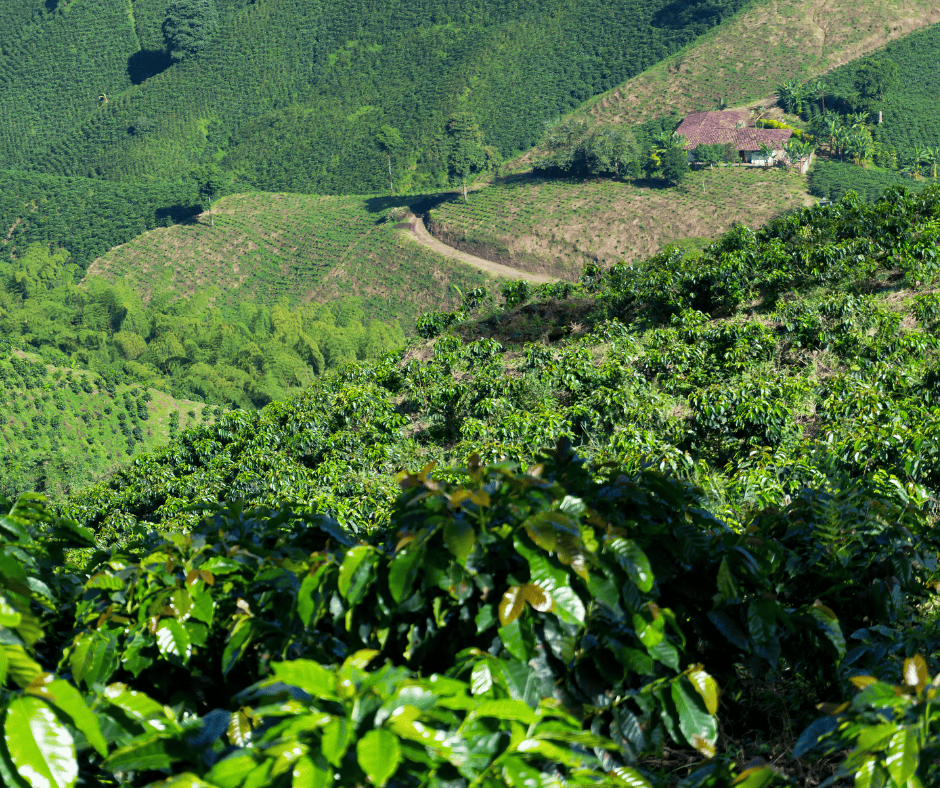Ever wondered how high altitude coffee affects taste? Coffee grown at high elevations is known for its rich, complex flavors and superior quality. Read on to discover why altitude plays a crucial role in coffee cultivation.
Coffee grown at high altitudes benefits from a slower maturation process, which results in richer and more complex flavor profiles. These high altitude coffee beans are often denser and smaller, typically exhibiting a brighter acidity and pronounced sweetness. When selecting high altitude coffee, it is advisable to look for labels indicating the elevation and to seek out trusted coffee-growing regions such as Colombia, Costa Rica, and Ethiopia, which are renowned for producing some of the best and most flavorful high altitude coffees.
The Importance of High Altitude in Coffee Cultivation
High altitude plays a pivotal role in coffee cultivation. It’s not just about the stunning landscapes; the elevation at which coffee is grown significantly influences the growth rates, bean development, and overall coffee quality. Whether you’re sipping a robusta or an arabica, understanding the impact of altitude can enhance your appreciation for your daily cup.
Coffee grown at higher elevations generally boasts richer and more diverse flavor profiles due to slower growth conditions and extended maturation periods. The unique climate conditions at high altitudes contribute to the development of complex flavors, making these coffee beans highly sought after by coffee connoisseurs around the globe. Additionally, where coffee beans grow at high altitudes, the resulting coffee growing beans are often of superior quality. The coffee bean is a key element in this process.
Growth Rates and Maturation
At higher altitudes, cooler and warmer temperatures slow down the maturation process of coffee plants. This slower growth rate allows the beans to mature slowly, which enhances the development of sugars and leads to more complex flavors. Imagine a fine wine that improves with age—the same principle applies to high altitude coffee.
The extended growth cycle at higher elevations results in intricate flavor profiles and improves the coffee beans’ overall sweetness. Coffee beans grown at elevations starting at 3,000 feet reveal complex flavors due to effective maturation in cooler temperatures.
Bean Density and Size
The physical differences in coffee beans grown at high altitudes are pretty remarkable. Higher altitude results in smaller, denser beans. This density results from the slower maturation process, which allows the beans to develop more sugars and complex flavors.
Beans cultivated at high altitudes also tend to exhibit a pronounced sweetness alongside bright acidity. Beans grown above 6,562 feet often display exceptionally vibrant and complex flavor characteristics. These denser beans delight the taste buds and the senses.
Climate Conditions
High altitudes provide a unique climate with cooler temperatures and different solar exposure, key factors influencing coffee cultivation. At these elevations, cooler temperatures slow the growth of coffee plants, resulting in beans that possess enhanced flavor complexity. The interplay of temperature, sunlight, oxygen, and rainfall creates unique microclimates essential for producing distinctive coffee flavors.
Direct sunlight availability at high altitudes promotes optimal photosynthesis in coffee plants, which is vital for quality bean development. Moreover, high altitude environments have less oxygen, which can impact the physiological stress of coffee plants and affect overall bean development. This unique combination of factors contributes to the superior quality of high altitude coffee.
Rainfall patterns at high elevations are often distinct, influencing water availability crucial for coffee plant health and flavor outcomes. The specific climate conditions at high altitudes are generally more favorable for developing complex flavors in coffee beans than warmer climates at sea level.
Flavor Profiles of High Altitude Coffee
High altitude coffees are celebrated for their exceptional flavor profiles. The slower growth cycle at higher elevations results in beans with richer and more complex flavors. These high elevation coffees typically possess a bright acidity and a range of intricate flavors, making them a favorite among coffee aficionados.
The complexity and density of flavors in high altitude coffee are often attributed to the unique growing conditions and fertile volcanic soils found in these regions. Here are the specific flavor attributes that make high altitude coffee stand out.
Bright Acidity and Sweetness
High altitude coffee is renowned for its bright acidity and complex sweetness. The combination of warm days and cool nights at higher elevations aids in the gradual maturation of coffee cherries, leading to the development of more sugars and intricate flavor profiles. This results in a coffee taste that is both vibrant and sweet. Additionally, the unique conditions contribute to the quality of coffee cherry, enhancing the higher acidity.
Colombia and Costa Rica are particularly known for producing high altitude coffees with nuanced taste profiles. If you’ve ever enjoyed a cup of Colombian coffee, you might have noticed its pronounced sweetness and bright acidity, which are hallmarks of high altitude cultivation.
Complexity and Intricate Flavors
Coffee beans grown at elevations of 3,000 to 5,000 feet exhibit a greater complexity in flavor. Higher elevations produce harder coffee beans, which contributes to their overall quality and flavor profile. These lower elevation coffee beans develop complex sugars that result in pronounced sweetness and intricate flavor profiles.
Costa Rica and Ethiopia are prime examples of regions that offer single-origin coffees known for their unique flavor attributes. The coffee plant thrives in these high altitude areas, developing complex and nuanced flavors that are highly prized by coffee enthusiasts.
Examples from Around the World
Regions like Ethiopia are celebrated for producing coffee with nuanced flavors, which is attributed to their high altitude growing conditions. Ethiopian coffee from regions like Yirgacheffe is renowned for its vibrant flavors and complexity, often featuring floral and citrus notes.
Costa Rican coffee from regions like Tarrazú is another excellent example of the best coffee. This high-grown arabica coffee is noted for its balanced flavor and acidity, making it a favorite among coffee lovers. Regions like Costa Rica, Guatemala, and Central America produce high-quality coffee at altitudes above 4,500 feet, resulting in rich and complex flavor profiles.
Other notable regions include Colombia, Kenya, and Papua New Guinea, each offering distinct flavors influenced by their high altitude environments. These mountainous regions contribute significantly to the world’s coffee landscape, providing unique and flavorful cups that are cherished globally.
Soil and Environmental Factors
The specific soil composition found at higher elevations can significantly impact the quality of coffee beans. High altitude regions often feature well-draining volcanic soils, which are beneficial for coffee growth due to their rich mineral content. These environmental factors play a crucial role in coffee cultivation and flavor development.
The ideal pH level for coffee cultivation is slightly acidic, typically between 5.5 and 6.5, ensuring optimal nutrient absorption. Soil composition and other environmental variables significantly influence the quality and flavor of high altitude coffee.
Soil Composition and Fertility
Elevation leads to diverse soil characteristics, which can vary significantly at different elevations. These variations in soil composition influence the flavor profiles of coffee. High altitude regions often have soils rich in minerals like phosphorus and potassium, which are vital for coffee growth.
These fertile soils not only support the health of the coffee plants but also enhance the overall quality of the beans. The richness of the soil at high altitudes contributes to the complexity of the coffee’s flavors.
Sunlight and Temperature
High altitude climates generally offer consistent cooler climates, essential for optimal growing coffee. These cooler temperatures slow the maturation process, allowing the green coffee beans to develop complex flavors and bright acidity. Direct sunlight exposure is crucial for coffee plants, as it aids in the photosynthesis process necessary for healthy growth.
High altitudes offer a frost-free climate with stable temperatures, which are crucial for optimal coffee growth. This combination of sunlight and temperature contributes significantly to the quality and flavor of high altitude coffee.
Other Environmental Variables
Altitude influences climate conditions that directly impact coffee quality. Oxygen levels at high altitudes can affect plant metabolism, impacting coffee beans’ overall health and flavor profile. Understanding how altitude influences intricate flavors in coffee helps appreciate coffee quality.
Rainfall patterns and other environmental variables also play a crucial role in coffee cultivation. Together, these factors create the unique microclimates essential for producing the distinctive flavors found in high-altitude coffee.
Comparing High Altitude and Low Altitude Coffees
High altitude coffee is often superior in quality, typically involving Arabica beans which are commonly grown above 2,000 feet. These high altitude beans tend to have a denser formation and more desirable characteristics than those grown at lower elevations. Understanding these differences can elevate your higher elevation coffee experience with the best coffee beans.
Look for terms like ‘high altitude’ or ‘strictly hard beans’ on coffee packaging to identify high altitude coffees. Here are the specific differences in flavor, bean quality, and consumer preferences between high and low altitude coffees.
Flavor and Acidity Differences
High altitude and low altitude coffees exhibit distinct differences in flavor and acidity at different altitudes. Coffees cultivated at higher elevations are characterized by brighter acidity and stronger flavor notes. This results in a more vibrant and flavorful cup compared to low altitude coffee.
Lower elevation coffee generally possesses a milder flavor profile and lower acidity compared to high altitude coffee. In summary, high altitude coffees typically offer a vibrant flavor and acidity, whereas low elevations coffees are softer and earthier. Additionally, lower altitude coffee can also provide a unique taste experience.
Bean Quality and Yield
Rainfall patterns significantly influence coffee yield. Optimal amounts of rainfall during various growth stages are needed to prevent issues like blossom loss and enhance yield. Regions that receive consistent precipitation throughout the year enable optimal growth and higher quality coffee beans.
High altitude coffee plants typically yield denser beans, which can enhance flavor retention during roasting. This results in a higher quality product that is highly valued in the coffee market.
Consumer Preferences
Many consumers favor high altitude coffee for its enhanced flavor complexity and aromatic qualities, viewing it as a premium option over low altitude varieties. Coffee drinkers appreciate the richer and more nuanced flavors offered by high altitude coffees.
Studies indicate that consumers tend to prefer high elevation coffees for their vibrant acidity and complex flavor profiles. This preference underscores the premium quality associated with high altitude coffee.
Practical Tips for Choosing High Altitude Coffee
Choosing the right high altitude coffee can be a delightful adventure. Look for beans labeled as ‘alta’ or ‘altura’, which indicate they are grown at higher elevations. These labels often highlight the elevation on coffee bags, helping you identify high altitude coffees with more complex flavors.
Here are practical tips on reading coffee labels, trusted regions and varieties, and tasting notes to look for when selecting high altitude coffee.
Reading Coffee Labels
Many roasters highlight elevation on coffee bags, making it easier for consumers to identify high altitude coffee. Higher elevation beans are often associated with more complex flavors, and labels play a crucial role in helping consumers identify high altitude coffee.
Consumers should look for elevation information on labels to guide their selection of high altitude coffee. This ensures you are choosing a product that offers the rich and nuanced flavors you desire.
Trusted Regions and Varieties
When selecting high altitude coffee, knowing the trusted regions and varieties can make a big difference. Mexican coffee labeled as ‘Altura’ signifies it is grown at high elevations, which enhances its flavor complexity. These high altitude varieties develop pronounced flavor profiles, including complexity and depth, which are highly sought after.
Other renowned high altitude coffee regions include Costa Rica, Ethiopia, and Colombia. These regions are celebrated for their rich, complex flavors that high altitude cultivation brings. Seeking out single origin coffees from these areas can ensure a high-quality coffee experience.
Tasting Notes to Look For
High altitude coffees are known for their unique and distinctive flavor profiles, which stand out in the coffee market. Due to the cooler temperatures and slower maturation processes, these coffees often exhibit bright acidity and pronounced sweetness. When tasting high altitude coffee, look for notes of citrus, chocolate, and floral hints, which indicate its complex nature.
These intricate flavor profiles provide a rich tasting coffee experience that is highly valued by coffee enthusiasts. Recognizing these tasting notes can help you appreciate the quality and craftsmanship that goes into producing coffee’s flavor profile. High altitude coffee tastes high altitude coffee.
Understanding the Effects of High Altitude on Coffee
High altitude coffee offers a unique and richer tasting experience thanks to the specific growing conditions found at higher elevations. The slower growth rates, denser beans, and intricate flavor profiles make high altitude coffee a premium choice for coffee lovers. Understanding the impact of altitude on coffee cultivation allows you to appreciate the complexities and nuances in every cup.
From the fertile volcanic soils to the cooler temperatures, every environmental factor plays a crucial role in developing the exceptional flavors of high altitude coffee. Next time you pick up a bag of beans, consider choosing one that proudly states its high altitude origins. Your taste buds will thank you for it!
Frequently Asked Questions
Why does high altitude affect coffee flavor?
High altitude enhances coffee flavor because it slows down the growth of the coffee plants, resulting in richer sugars and more complex flavors. So, those mountainous beans really pack a punch in taste!
What are the typical flavor notes of high altitude coffee?
High altitude coffee usually has bright acidity and a sweet, complex flavor profile that includes citrus, chocolate, and floral notes. It’s definitely a treat for your taste buds!
How can I identify high altitude coffee when buying?
When buying coffee, check for labels that say ‘high altitude,’ ‘alta,’ or ‘Altura’; these terms mean the coffee was grown at elevated locations, leading to more decadent flavors.
What are some trusted regions for high altitude coffee?
If you’re looking for high altitude coffee, check out Costa Rica, Ethiopia, Colombia, and Mexico’s ‘Altura’ regions. These spots are renowned for their delicious, high-quality beans!
Why do consumers prefer high altitude coffee?
Consumers love high altitude coffee because it offers richer flavors and a more interesting aroma. The higher elevation brings out a vibrant acidity and unique taste that’s hard to resist.


















